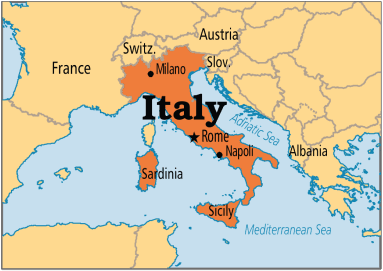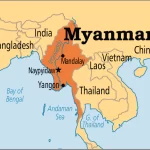
• Both India and Italy are old cultures, but Italy is a young country. It was only reunified in 1861. Sanskrit and Latin are both part of the Indo-European language family.
• For more than 2,000 years, people from these two old societies have known each other, talked to each other, and traded with each other. On the spice route, the ports of Italy were important places to trade.
• During his trips to the east, the Venetian merchant Marco Polo went to India in the 1300s and wrote about what he saw and did there. In 1419, Niccol de’ Conti left Venice for the Middle East, Persia, and India.
• The two countries now talk to each other because thinkers from both sides talk to each other.
In 1926, Nobel Prize winner Rabindranath Tagore went to Italy at the request of Carlo Formichi, a Sanskrit professor at the University of Rome.
In 1931, on his way back to India from the Round Table Conference in London, Gandhi stopped in Rome.
• Leaders of the Indian freedom movement read the writings of Mazzini, an Italian rebel who worked for the Democratic Republic of Italy at the beginning of the 19th century.
• During World War II, Indian soldiers who were part of the British Indian Army were involved in Italy. The Rajputana Rifles and the Gurkha Rifles were two of these.
• The 10th Indian Division fought against the Italians in Somaliland and Abyssinia as part of the East African Allied operation.
• Italy has helped India join export control groups like the Australia Group, the Missile Technology Control Regime (MTCR), and the Wassenaar Arrangement.
Table of Contents
Areas of Cooperation
Political and Strategic Relations
• In 1947, India and Italy began to have political ties. In March 2018, 70 years of official ties between India and Italy came to an end.
• Between the two countries, political and government leaders have been visiting each other often. In October 2018, Italy’s Prime Minister Giuseppe Conte went to India and signed a number of agreements, including a joint agreement to stop funding for terrorism and to punish countries that support terrorism. Also, both countries talk to each other regularly through the Senior Officials Dialogue (Foreign Office Consultations), the Joint Commission on Economic Cooperation, and the India-Italy Technology Summit. Italy has also shown its support for India’s efforts to join the Nuclear Suppliers Group, which shows that Rome wants India to be a member of the global technology export groups.
Economic and Commercial Relations
• India’s trade with Italy was worth USD 8.79 billion in 2016-17, making it the country’s fifth largest business partner in the EU.
• India sold about USD 4.90 billion worth of goods to Italy, but only bought about USD 3.89 billion worth of goods from Italy. This gave India a trade surplus of about USD 1 billion. There is a lot of room for our trade with each other to grow much more.
• The main things India sends to Italy are ready-made clothes, leather, iron ore, cars, linens, chemicals, gems and jewellery. Italy’s main exports are machines for both general and specific uses, machine tools, metal products, and engineering goods.
• There are about 140 big Italian companies that do business in India. Some of the biggest Italian companies that have invested in India are FIAT Auto, Heinz Italia, FIOIA, Italcementi, etc.
• There are Indian companies in Italy in fields like IT, electronics, pharmaceuticals, cars, textiles, and building. Indian companies like Tata, TCS, Wipro, Engineers India Limited, L&T, Mahindra & Mahindra, Ranbaxy, Raymonds, etc. are well-known in Italy.
• If India and the European Union (EU) sign the Bilateral Trade and Investment Agreement (BTIA), trade and investment between India and Italy would get even better.
Diaspora and Cultural Relations
• There are about 2.4 lakhs and 25000 PIOs in the Indian community in Italy. This makes it the third biggest Indian community in Europe, after the UK and the Netherlands.
According to official data from the Italian Ministry of Labour and Social Policy, there are 1.65 lakh legal Indian migrants in Italy in 2020. This is 4.4% of non-EU citizens and makes them the 5th largest foreign community in Italy. Most of them are first-generation migrants who work in agriculture, dairy farming, the leather industry, construction, and the service industry.
A lot of the Indian diaspora lives in the Lombardy, Piemonte, Veneto, and Emilia Romagna regions of northern Italy, as well as in Florence, Rome, and the Campania, Puglia, and Calabria regions of southern Italy. The agreement for cultural cooperation was signed in 1976. In July of 2004, a new Agreement took its place. It includes the Cultural Exchange Programme (CEP) between Italy and India, in which students take language classes and other classes in each other’s countries.
In Italy, there are about 10 colleges and universities with highly trained teachers that offer classes in Indian art, history, and languages.
• In June 2014, Air India, the national airline of India, started flying between Rome and Milan in Italy and New Delhi. This made it possible for tourists and businesspeople from India and Italy to travel to each other’s countries for both work and pleasure.
• Hindi and Sanskrit are taught to Italian kids at many of the best schools. On June 21, 2015, the first International Day of Yoga was held for the first time.
• On January 18, 2021, the Embassy of India started the “Srijan” Festival of India in Italy, which will last for a whole year.
The festival’s goal is to bring Italians together and give them a chance to learn about India’s rich design, history, literature, and languages.
Science & Tech
• Since 1978, there has been an Agreement on S&T Co-operation.
Under the Agreement’s three-year action plans, up to thirty joint research projects can be done. Some of the best areas for joint research are electronics, biotechnology, design engineering, automotive technologies, energy, etc.
Defence
• Defence cooperation has always been an important part of the relationship between India and Italy. In November 1994, an MOU on defence cooperation was signed.
The Indian Army has been linked to Italy in the past. With more than 50,000 troops, the 4th, 8th, and 10th Indian Divisions were a big part of one of the hardest allied advances to free Italy during World War II. In 2018, the Joint Defence Committee was set up to improve and encourage a “structured dialogue” between Indian and Italian defence firms.
• Italy backed India’s “intensified engagement” with export control regimes for nuclear, missile, and dual-use technology and substances. These include the Wassenaar Arrangement, the Australia Group, and the Nuclear Suppliers’ Group (NSG), all of which work to stop the spread of nuclear weapons around the world.
Support in anti-terrorism
• Italy has helped India in the fight against terrorism. India has been asking the world for a long time to be more active and strict against terrorist groups, especially the JeM, which is based in Pakistan and is responsible for cross-terrorism. Italy’s support in this matter helps India in its fight against terrorism around the world, especially in Pakistan. Today, terrorism is a problem all over the world, not just in India. When countries recognise terrorist groups like Al-Qaida and ISIS, they are asked not to give them a safe place to live.
• India is being attacked by terrorists, while Italy is getting a lot of people from Syria, Yemen, Libya, and other places in Europe. So, Italy’s security is also becoming more of a worry, and it’s important that this is talked about freely.
• Italy thinks that India has been worried about cross-border terrorism for a long time, and now it is becoming a fact.
• The horrible terrorist attacks in Europe make me think that maybe Europe is now a little more aware of how to deal with a country like India when it comes to anti-terrorism.
Significance of India and Italy’s partnership
• Strong manufacturing base: With a GDP of $1.86 trillion, Italy is the third biggest economy in the Eurozone, after Germany and France, and the eighth largest economy in the world. It is also the sixth biggest manufacturing country in the world. Most of its factories are small and medium-sized businesses, which are grouped together in many industrial districts.
• Brexit: Half of India’s investments in the EU are in the United Kingdom. Because of this, Indian companies are looking for other ways to get into the EU market. This is a great chance to do that in Italy.
• The strategic dynamics between India and Europe: India has tried to open its policy towards Europe, while Europe has become more focused on itself after Brexit and the rise of far-right parties across the region. So India wants to build a way to connect to the EU.
• G20: Italy will be in charge of the G20 in 2021 and India will be in charge in 2022. The G20 is one of the most important places for global government.
• Fight against climate change. In 2021, Italy and the United Kingdom will co-host COP26, the 26th sitting of the Conference of the Parties. India is one of the world’s most important responsible stakeholders.
• Africa: Both India and Italy are becoming more involved in the continent. For Italy, this is to help control the flow of migrants, and for India, it is to help build cooperation.
Challenges
• Less trade. India and Italy have been trading partners since Roman times, so it’s a shame that India doesn’t do as much business with other countries.
• The Enrica Lexie Case: In 2012, two Indian fishermen were killed by Italian marines. This was a big mistake, and it didn’t take long for this sad event to become political.
• Italy’s political situation is very unstable, with a nationalist, naturalist, almost fascist group on one side and a populist group on the other. • Italy is the “Achilles heel of Europe,” with one of the lowest growth rates at 1.5%, high youth unemployment at 30%, and rising debt at a worrying 133% of its GDP.
Enrica Lexie Case
Two Italian marines on the ship Enrica Lexie were arrested in 2012 for allegedly killing two Indian fishermen off the coast of Kerala. Italy said the ship was in international waters and that only the International Tribunal for the Law of the Sea (ITLOS) should be in charge of the case. It also shook up the world court. Latorre went back to Italy in September 2014, after the Supreme Court told him to for health reasons. Girone was free to leave in May 2016.
• The diplomatic fight between India and Italy also hurt the ties between the European Union and India. Also, Italy faces big problems like an economic downturn (high unemployment, low growth rates, and rising debt), a tendency to focus on itself, the refugee crisis, the effects of Brexit, and some doubt about the future of Europe.
• In this situation, India can be a very important partner for Italy and Europe.
The Next Steps
• Both countries should shape the international conversation around issues that are important to both of them, such as: taking advantage of how our economies complement each other; strengthening our partnership based on shared values; our thriving creative industries; our scientific knowledge and technological skills; the development of a rules-based international system; the promotion of fair trade; inclusive growth; and the realisation of the 2030 Agenda.
• Supporting an effective international system, which would be the best way to speed up the political process and help us beat the new coronavirus and get back on our feet in a way that is fair and lasts.
• Improving trade: India and Italy have a lot of potential to do business together if India and the European Union (EU) sign the Bilateral Trade and Investment Agreement (BTIA), which they have been talking about for more than 11 years.
• The EU Strategy for Connectivity in Asia, which was just passed, will help improve ties between the EU and India.
• Italy has just joined the International Solar Alliance (ISA), reiterating its commitment to green energy and furthering India-Italy relations.
• Italy, which is a member of the EU, could be a good partner for India after the UK leaves the EU. It could also be a good place for Indian businesses to do business.
• Promoting ideas like democracy, free trade, security, and the rule of law, which are all part of how India and Italy act in the world, would require both countries to work together. This would affect planning and policy.





![Ancient History Notes for UPSC [Part 9] Growth of Trade 1626499692731_compress31](https://iasbio.com/wp-content/uploads/2021/07/1626499692731_compress31.jpg)










